OPEL ZAFIRA 2009 Repair Manual
Manufacturer: OPEL, Model Year: 2009, Model line: ZAFIRA, Model: OPEL ZAFIRA 2009Pages: 228, PDF Size: 7.3 MB
Page 61 of 228
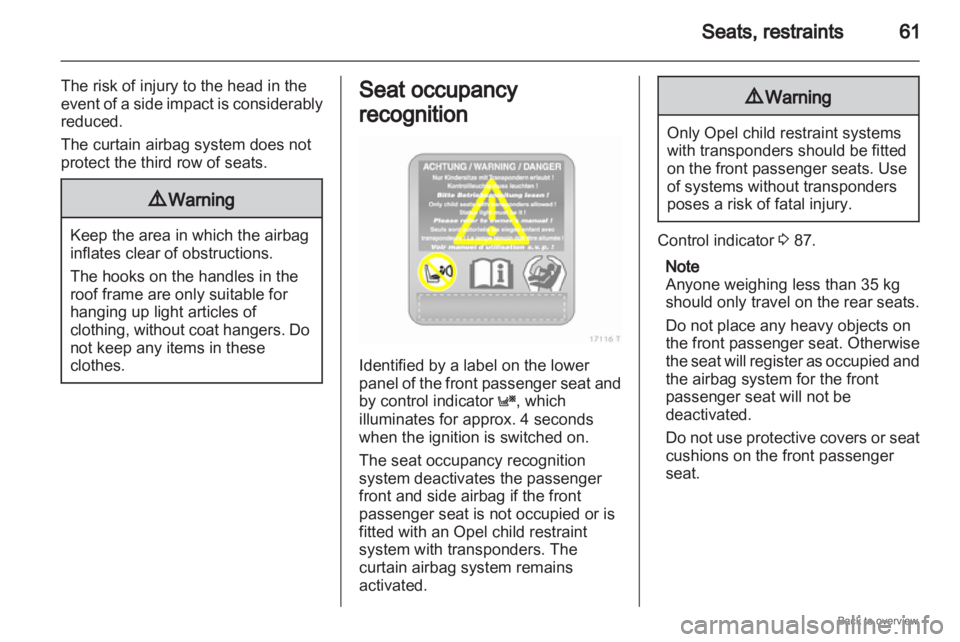
Seats, restraints
61
The risk of injury to the head in the
event of a side impact is considerably
reduced.
The curtain airbag system does not
protect the third row of seats. 9
Warning Keep the area in which the airbag
inflates clear of obstructions.
The hooks on the handles in the
roof frame are only suitable for
hanging up light articles of
clothing,
without coat hangers. Do
not keep any items in these
clothes. Seat occupancy
recognition
Identified by a label on the lower
panel
of the front passenger seat and
by control indicator y, which
illuminates for approx. 4 seconds
when the ignition is switched on.
The seat occupancy recognition
system deactivates the passenger
front and side airbag if the front
passenger seat is not occupied or is
fitted with an Opel child restraint
system with transponders. The
curtain airbag system remains
activated. 9
Warning Only Opel child restraint systems
with transponders should be fitted
on
the front passenger seats. Use
of systems without transponders
poses a risk of fatal injury. Control indicator
3 87.
Note
Anyone weighing less than 35 kg
should only travel on the rear seats.
Do not place any heavy objects on
the front passenger seat. Otherwise
the
seat will register as occupied and
the airbag system for the front
passenger seat will not be
deactivated.
Do not use protective covers or seat
cushions on the front passenger
seat.
Page 62 of 228
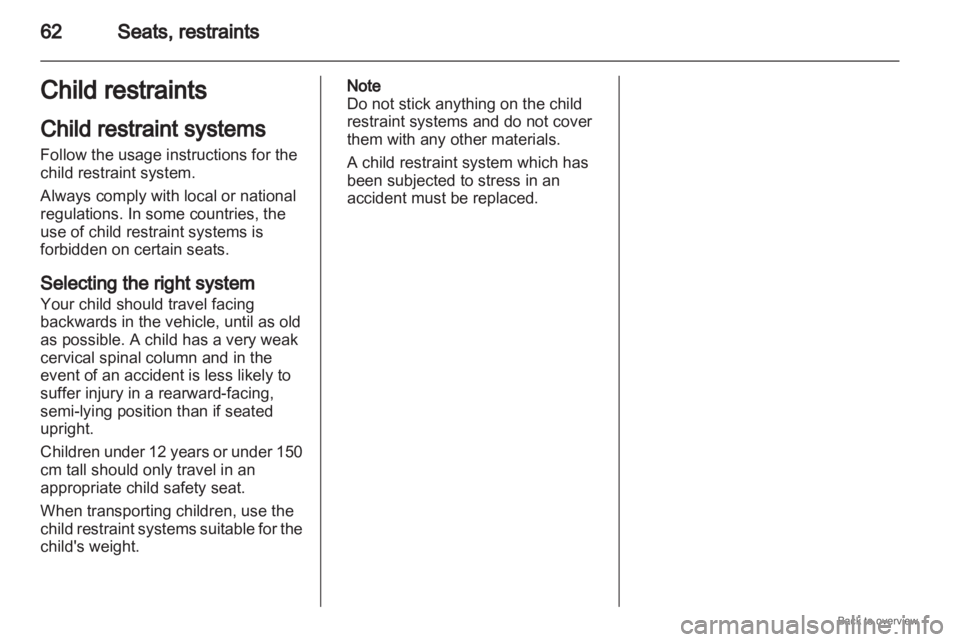
62
Seats, restraints
Child restraints
Child restraint systems
Follow the usage instructions for the
child restraint system.
Always comply with local or national
regulations. In some countries, the
use of child restraint systems is
forbidden on certain seats.
Selecting the right system
Your child should travel facing
backwards in the vehicle, until as old
as possible. A child has a very weak
cervical spinal column and in the
event of an accident is less likely to
suffer injury in a rearward-facing,
semi-lying position than if seated
upright.
Children
under 12 years or under 150
cm tall should only travel in an
appropriate child safety seat.
When transporting children, use the
child restraint systems suitable for the
child's weight. Note
Do not stick anything on the child
restraint systems and do not cover
them with any other materials.
A child restraint system which has
been subjected to stress in an
accident must be replaced.
Page 63 of 228

Seats, restraints
63
Child restraint installation locations
Permissible options for fitting a child safety seat
Weight and age class 1) On front passenger
seat On outboard
seats in the
second row On centre seat
in the second
row On the seats
in the third
row
Group 0: up to 10 kg or approx. 10 months
Group 0+: up to 13 kg or approx. 2 years
B
1
, + U, + U X
Group I: 9 to 18 kg or approx. 8 months to 4 years
B
2
, + U, +, ++ U UF
Group II: 15 to 25 kg or approx. 3 to 7 years
Group III: 22 to 36 kg or approx. 6 to 12 years
X U U UF
B
1
= Limited, only with seat occupancy recognition and Opel child restraint system with transponders.
If the child restraint system is being secured using a three-point seat belt, move seat height adjustment to uppermost
position. Move front passenger seat as far back as possible and move front passenger seat belt anchorage point to
lowest position.
B 2
= Limited, only with seat occupancy recognition and Opel child restraint system with transponders.
If
the child restraint system is being secured using a three-point seat belt, move seat height adjustment to uppermost
position. Move front passenger seat as far back as possible so that vehicle safety belt runs from anchorage point
towards the front.
U = Universal suitability in conjunction with three-point seat belt.
UF = Can be used universally for child restraint systems facing the front in combination with a three-point seat belt.
+ = Vehicle seat available with ISOFIX attachments. When attaching using ISOFIX, only the ISOFIX child restraint systems permitted for the vehicle may be used.
1) We recommend the use of each system until the child reaches the upper weight limit.
Page 64 of 228
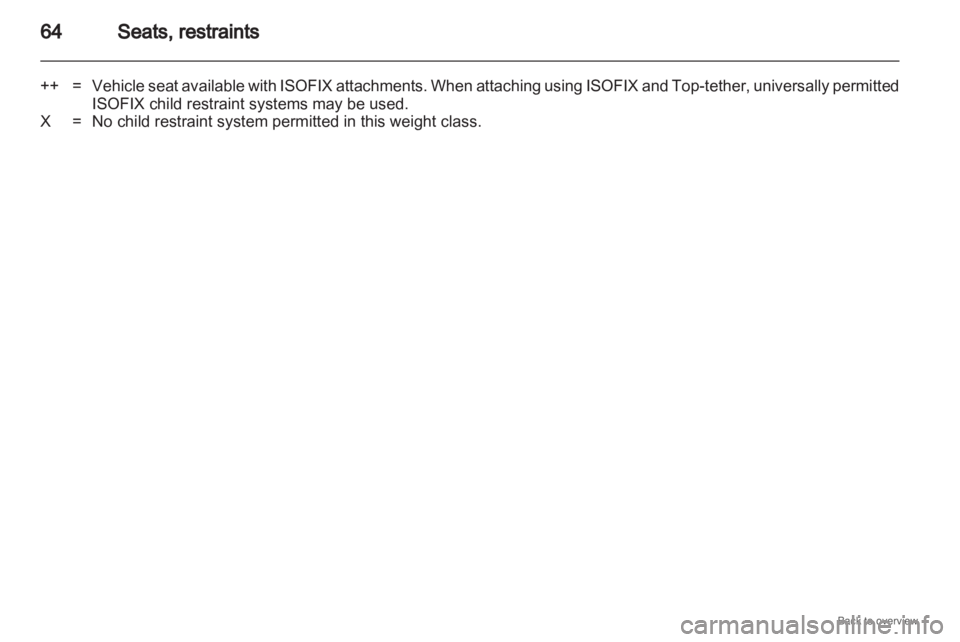
64
Seats, restraints
++ = Vehicle seat available with ISOFIX attachments. When attaching using ISOFIX and Top-tether, universally permitted
ISOFIX child restraint systems may be used.
X = No child restraint system permitted in this weight class.
Page 65 of 228
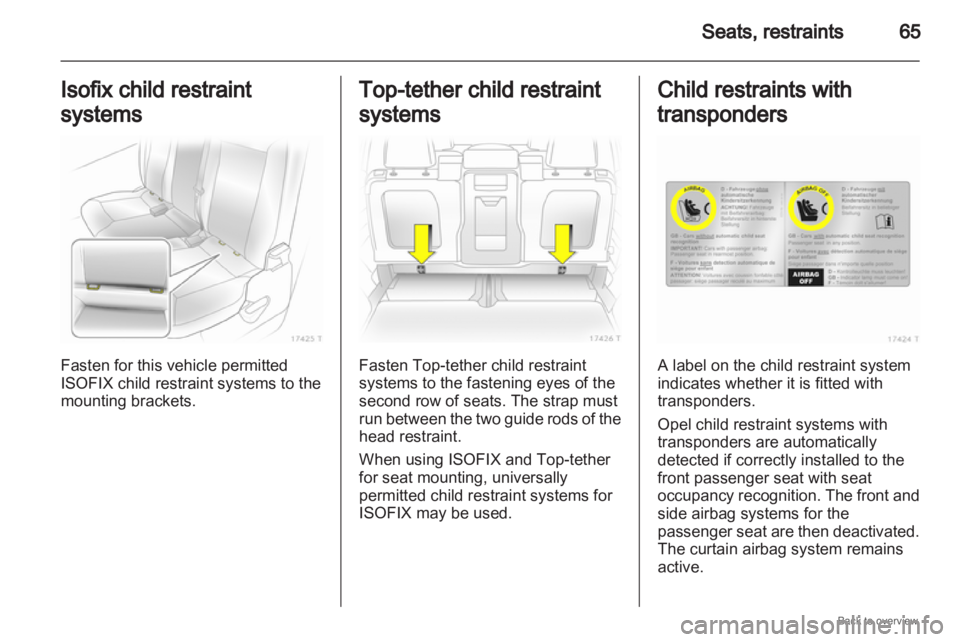
Seats, restraints
65
Isofix child restraint
systems Fasten for this vehicle permitted
ISOFIX child restraint systems to the
mounting brackets. Top-tether child restraint
systems
Fasten Top-tether child restraint
systems to the fastening eyes of the
second row of seats. The strap must
run
between the two guide rods of the
head restraint.
When using ISOFIX and Top-tether
for seat mounting, universally
permitted child restraint systems for
ISOFIX may be used. Child restraints with
transponders
A label on the child restraint system
indicates whether it is fitted with
transponders.
Opel child restraint systems with
transponders are automatically
detected if correctly installed to the
front passenger seat with seat
occupancy
recognition. The front and
side airbag systems for the
passenger seat are then deactivated.
The curtain airbag system remains
active.
Page 66 of 228
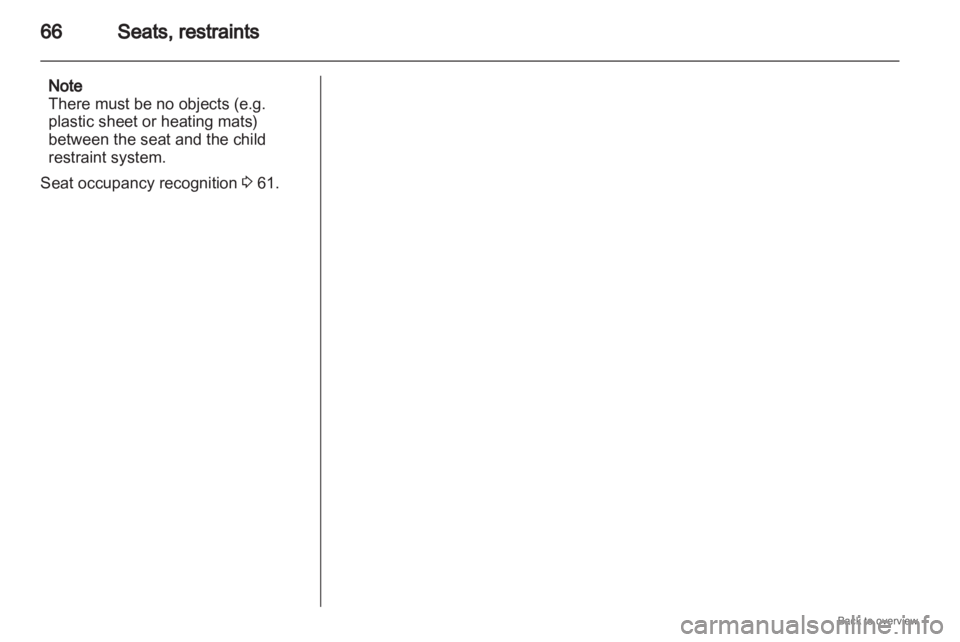
66
Seats, restraints
Note
There must be no objects (e.g.
plastic sheet or heating mats)
between the seat and the child
restraint system.
Seat occupancy recognition 3 61.
Page 67 of 228

Storage
67
Storage
Storage compartments ................67
Load compartment .......................69
Roof rack system .........................74
Loading information .....................75 Storage compartments
Glovebox
The glovebox features a pen holder.
The
glovebox should be closed whilst
driving. Cupholders
Cupholders are located in the centre
console,
in the doors and the rear side
panelling.
Page 68 of 228
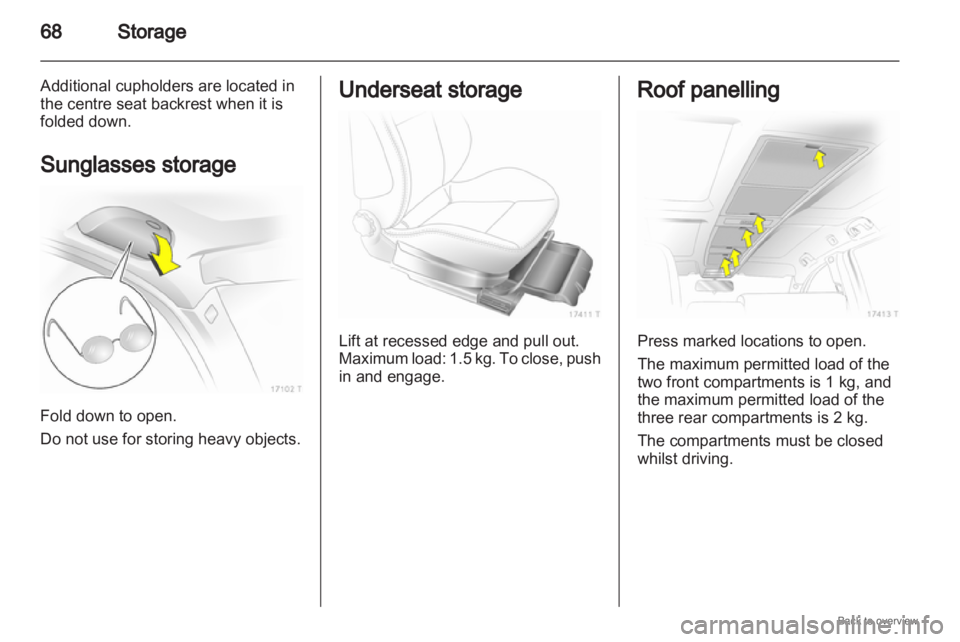
68
Storage
Additional cupholders are located in
the centre seat backrest when it is
folded down.
Sunglasses storage Fold down to open.
Do not use for storing heavy objects. Underseat storage
Lift at recessed edge and pull out.
Maximum
load: 1.5 kg. To close, push
in and engage. Roof panelling
Press marked locations to open.
The maximum permitted load of the
two front compartments is 1 kg, and
the maximum permitted load of the
three rear compartments is 2 kg.
The compartments must be closed
whilst driving.
Page 69 of 228
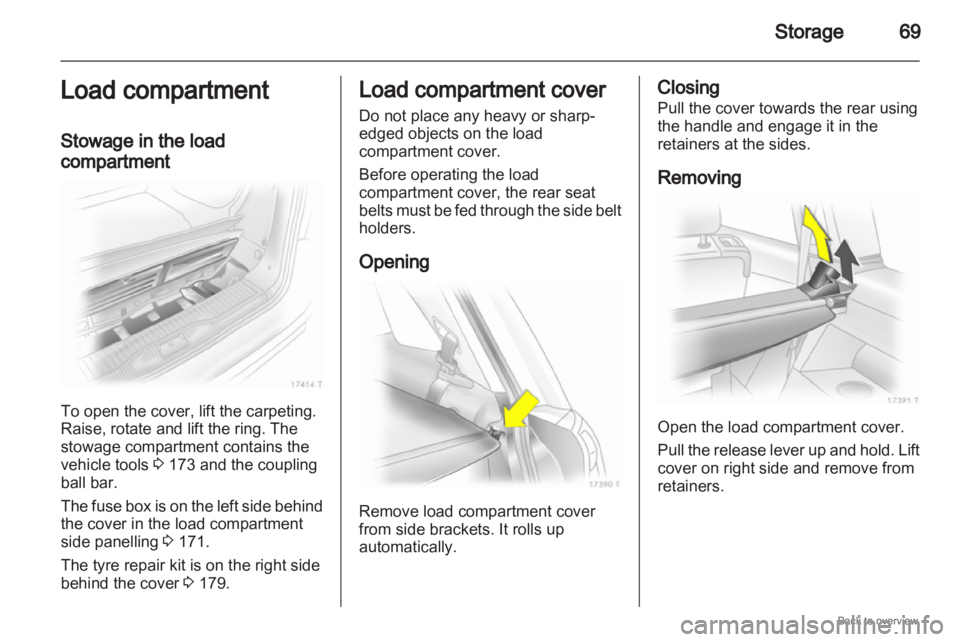
Storage
69
Load compartment
Stowage in the load
compartment To open the cover, lift the carpeting.
Raise, rotate and lift the ring. The
stowage compartment contains the
vehicle tools
3 173 and the coupling
ball bar.
The
fuse box is on the left side behind
the cover in the load compartment
side panelling 3 171.
The tyre repair kit is on the right side
behind the cover 3 179. Load compartment cover
Do not place any heavy or sharp-
edged objects on the load
compartment cover.
Before operating the load
compartment cover, the rear seat
belts
must be fed through the side belt
holders.
Opening Remove load compartment cover
from side brackets. It rolls up
automatically. Closing
Pull the cover towards the rear using
the handle and engage it in the
retainers at the sides.
Removing
Open the load compartment cover.
Pull
the release lever up and hold. Lift
cover on right side and remove from
retainers.
Page 70 of 228
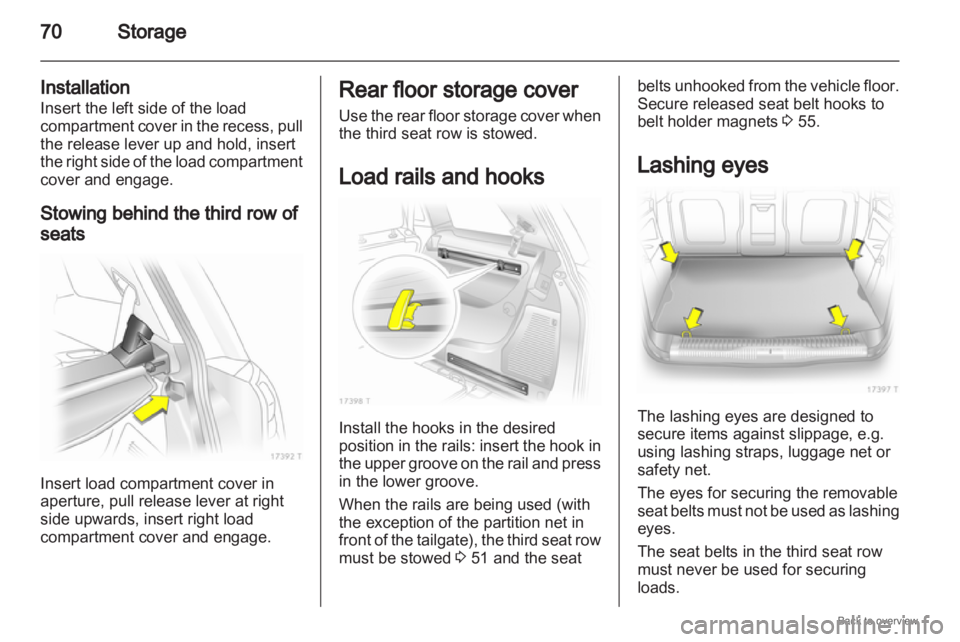
70
Storage
Installation
Insert the left side of the load
compartment cover in the recess, pull
the release lever up and hold, insert
the right side of the load compartment
cover and engage.
Stowing behind the third row of
seats Insert load compartment cover in
aperture, pull release lever at right
side upwards, insert right load
compartment cover and engage. Rear floor storage cover
Use
the rear floor storage cover when
the third seat row is stowed.
Load rails and hooks Install the hooks in the desired
position
in the rails: insert the hook in
the upper groove on the rail and press
in the lower groove.
When the rails are being used (with
the exception of the partition net in
front of the tailgate), the third seat row
must be stowed 3 51 and the seat belts unhooked from the vehicle floor.
Secure released seat belt hooks to
belt holder magnets
3 55.
Lashing eyes The lashing eyes are designed to
secure items against slippage, e.g.
using lashing straps, luggage net or
safety net.
The eyes for securing the removable
seat
belts must not be used as lashing
eyes.
The seat belts in the third seat row
must never be used for securing
loads.